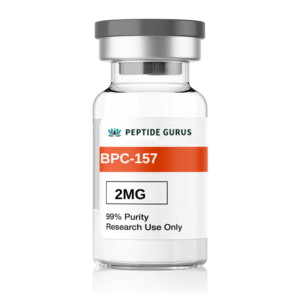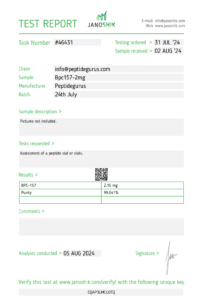In the vast landscape of medical research, the quest for effective tissue healing solutions is ongoing. BPC-157, a remarkable peptide, has emerged as a potential game-changer in this field. Our BPC-157 2mg peptide product offers researchers a high-quality option for delving into its tissue healing properties.
BPC-157 is a stable gastric pentadecapeptide, which means it is composed of 15 amino acids. It is derived from a protein found in the stomach. This peptide has attracted significant attention due to its unique set of properties that make it promising for tissue healing research.
The specific amino acid sequence of BPC-157 gives it its distinct characteristics. Amino acids are like the building blocks of proteins and peptides, and their arrangement in BPC-157 allows it to interact with cells and tissues in the body in specific ways. Although the exact molecular formula may vary depending on the synthesis method, its consistent structure ensures reliable biological activity.
Fibroblast Activity Promotion: Fibroblasts are key cells in the tissue repair process. They are responsible for producing the extracellular matrix, which provides a framework for new tissue growth. BPC-157 promotes the rapid spread and proliferation of fibroblasts at the site of injury. This increased fibroblast activity leads to a more efficient production of the extracellular matrix components, such as collagen and elastin. Collagen, in particular, is essential for the strength and integrity of the repaired tissue.
Angiogenesis Enhancement: Another crucial aspect of tissue healing is the formation of new blood vessels, a process known as angiogenesis. BPC-157 has the ability to improve blood vessel growth. By enhancing angiogenesis, it ensures that the injured tissue receives an adequate supply of oxygen and nutrients. This is vital for the survival and function of the cells involved in the repair process. Additionally, the new blood vessels help in removing waste products from the injury site, creating a more favorable environment for tissue regeneration.
Injuries to muscles, tendons, and ligaments are common, and their healing can be a long and complex process. BPC-157 has shown great potential in accelerating the healing of these tissues. In pre-clinical studies, it has been observed to reduce the time required for muscle recovery after injury. It helps in the regeneration of damaged muscle fibers and improves the strength and functionality of the repaired muscle.
For tendons and ligaments, BPC-157 promotes the alignment of collagen fibers during the healing process. Properly aligned collagen fibers are essential for the mechanical strength of tendons and ligaments. By enhancing this alignment, BPC-157 may help prevent future injuries and improve the overall quality of the healed tissue.
Wound healing is a multi-step process that involves inflammation, cell proliferation, and tissue remodeling. BPC-157 plays a role in each of these stages. Its anti-inflammatory properties help to reduce the initial inflammatory response at the wound site, which can prevent excessive tissue damage. During the cell proliferation stage, it stimulates the growth of various cell types involved in wound healing, such as fibroblasts and endothelial cells. And in the tissue remodeling stage, it aids in the formation of a strong and functional scar tissue.
Our BPC-157 2mg peptide product is of the highest quality, with a purity of 99%. This high purity is crucial for obtaining reliable and accurate research results. Whether researchers are conducting in vitro experiments on cell cultures or in vivo studies on animal models, our product provides a consistent and dependable source of BPC-157.
To maintain the integrity of our BPC-157 peptide, proper storage and handling are essential. The peptide is typically provided in a lyophilized (freeze-dried) form. It should be stored at a recommended temperature, usually around -20°C. This low temperature helps to preserve the peptide’s structure and activity. When handling the peptide, researchers should follow strict laboratory protocols. This includes using sterile equipment, working in a clean environment, and avoiding any potential sources of contamination.
As of now, BPC-157 is not an FDA-approved drug for tissue healing or any other indication in humans. However, the FDA has established guidelines for the development and testing of new drugs and biologics. For researchers using our BPC-157 peptide in tissue healing research, these guidelines are of utmost importance.
The FDA requires comprehensive pre-clinical studies to evaluate the safety and efficacy of new substances. This includes in vitro assays to understand the peptide’s mechanism of action, as well as in vivo animal studies to assess its toxicity, pharmacokinetics (how the body processes the peptide), and potential therapeutic effects. If the pre-clinical results are promising, researchers may then progress to clinical trials in humans. The FDA’s review process for clinical trials is rigorous, ensuring the protection of participants’ safety and the reliability of the data collected.
No, the BPC-157 peptide available from us is intended for research purposes only. It has not been approved by the FDA for human use. Self-treating injuries with this peptide can be dangerous and is not recommended. Any treatment for injuries should be done under the supervision of a qualified healthcare provider using FDA-approved treatments.
The
BPC-157 peptide should be stored at -20°C. This low temperature helps to maintain its stability. Avoid exposing it to higher temperatures or repeated freeze-thaw cycles, as this can degrade the peptide. If the peptide has been reconstituted, it should be stored at 2 – 8°C and used within the recommended time frame.
In tissue healing research, BPC-157 has generally shown good tolerance in animal models. However, as with any peptide, there is a potential for side effects. Some studies have reported mild local reactions at the site of administration. But more research is needed to fully understand its side effect profile, especially in the context of human use.

